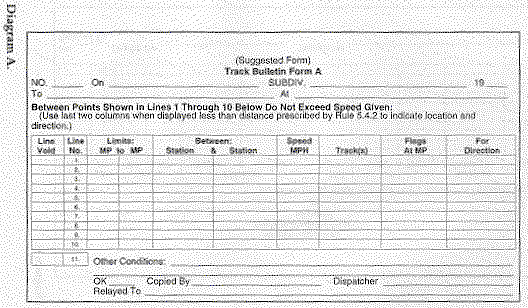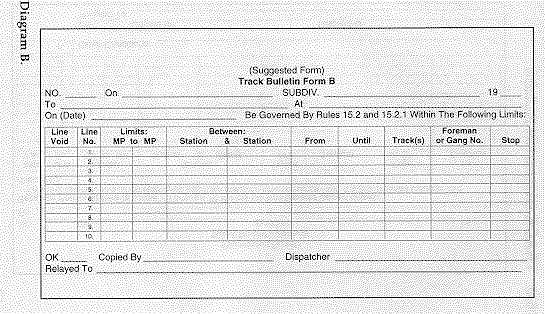


Receipt and Comparison of Track Bulletins
The conductor and engineer must receive a track warrant at their initial station unless otherwise instructed by the train dispatcher. All track bulletins that affect their train's movement must be listed on the track warrant, unless the track warrant shows "NONE" or "NO." The conductor and engineer must have copies of all track bulletins listed, and each crew member must read and understand them.
At the initial station, when outbound crew members receive track warrants and track bulletins from inbound crew members, the conductor and engineer must compare the track warrants and track bulletins with each other and with the train dispatcher before proceeding.
While trains are within the limits during the time stated in track bulletin Form B, they must:
Before entering track bulletin limits, a crew member must attempt to contact the employee in charge by radio to avoid delay and report the train's location and the track being used.
A. Verbal Permission
When granting verbal permission, use the following words:
"Foreman (name) (of Gang NO. ) using track bulletin
NO._______ line NO.________ between MP _________ and MP_________ on ____________Subdivision."
A crew member must repeat the above instructions, and the employee giving the instructions must acknowledge them before they can be followed.
C. Stop Column
When "STOP" is written in the Stop column, a red flag must be displayed at the beginning of the limits. The train must not enter the limits until authorized by the employee in charge.
While trains, engines, and protected equipment are in track bulletin limits, they will otherwise be governed by Rule 15.2 (Protection by Track Bulletin Form B). The same track bulletin must not protect other gangs and equipment.
The train must use only the track specified between these points. Opposing trains must not leave the last point until the train arrives. The train dispatcher must not authorize a following train to move against the current of traffic until the previous train has cleared the last point. Flag protection is not required against a train following on the same track.
The example may be modified as follows:
a. "After (opposing train) arrives at (point) (train) will use ________track against the current of
traffic (point) to (point)."
The train that will move against the current of traffic must not leave the first point until the opposing train arrives.
Trains directly affected in both directions must receive this track bulletin and must not:
Following Movement. A train may not follow another train against the current of traffic until the previous train has cleared the limits, passed a designated location, or passed a flagman located at the next intermediate point. Flag protection is not required against following trains.
Flagman Provided. When flagmen are provided, the example will be modified by adding:
a. "Intermediate flagman located at (point). Trains moving against the current of traffic must stop short of flagman unless directed to proceed."
Extending Time. Time may be extended by issuing another track bulletin as follows:
b. "Track bulletin NO. _______ is extended until (time)."
This bulletin will be used when one or more tracks will be removed from service, and all trains in both directions must use the remaining track as directed by the train dispatcher or an employee in charge of switches at each end of the designated limits.
The train dispatcher will authorize movements between the designated points and issue the track bulletin and necessary instructions to the employee in charge of switches. This employee may verbally direct movement or use hand signals. Also, the train dispatcher may use a controlled signal indication to authorize movement.
All affected trains must receive a copy of the track bulletin.
A track bulletin may protect tracks removed from service by designating the track and naming the points at each end of the track. Trains must not use this track, unless the track bulletin states the name or title of an employee who may authorize use, and this person directs all movement.
When required, the train dispatcher must advise crews of alternate routes and switch positions.
When the main track is blocked, provide protection as specified by Rule 6.19.6 (Protection of Equipment Left on Main Track).
General orders or special instructions cancelled by track bulletins must not be reinstated. The track bulletin must remain in effect until the general order that contains the change is posted.
Duplicated track bulletins must not be delivered or used until they are checked and verified as:
The train dispatcher will record the date, time, place, and name of the employee who recopied and repeated the track bulletin.
When directed by the train dispatcher, track bulletins may be retained for use during the next tour of duty. Before initiating movement on the main track on the next tour of duty, a crew member must verify from the train dispatcher that no additional track bulletins are needed.
If they cannot personally deliver the track warrants or track bulletins to the relieving crew, the conductor will leave them at a location designated by the train dispatcher.
Comparison of Information
The relieving conductor and engineer must compare track warrants, track bulletins, instructions, and pertinent information with each other and with the train dispatcher before proceeding.
A. Voiding Track Bulletins Verbally
Void the track bulletin by verbally using one of the following examples:
Issue a track bulletin or use the line designated "OTHER SPECIFIC INSTRUCTIONS" on a track warrant using one of the following examples:
15.2.1 Protection for On-Track Equipment
Track bulletin Form B may be used to protect on-track equipment, such as rail detector cars, without using flags. Identify protected equipment in the track bulletin.15.3 Authorizing Movement Against the Current of Traffic
Where Rule 9.14 (Movement with the Current of Traffic) is in effect, a track bulletin may authorize movement against the current of traffic as follows:
This bulletin may also contain information on public crossing protection, switches spiked, intermediate flagman, and so forth.
15.4 Protection when Tracks Removed from Service
Before a track is removed from service it must be protected.15.5 Protection when Tracks Blocked with Equipment
Notify the train dispatcher when main tracks, sidings, or other tracks that are normally clear are blocked with equipment and cannot be cleared.15.6 Change of a Rule, General Order, or Special Instruction
When authorized by the designated manager, a track bulletin may be used to issue, change, or cancel rules, general orders, or special instructions.15.7 Copying Track Bulletins
The conductor and the engineer must have a copy of each track bulletin issued to their train, and each crew member must read and understand them. The copy must show the date, location, and name of the employee who copied it. The following must occur when track bulletins are transmitted verbally:
Employees may relay track bulletins.15.8 Duplicating Track Bulletins
Employees who reproduce track bulletins with a duplicating machine do not need to repeat them to the train dispatcher.
15.9 Additional Copies of Track Bulletins
If additional copies of track bulletins are needed, except when duplicated according to Rule 15.8 (Duplicating Track Bulletins), employees must repeat the additional copies to the train dispatcher and verify that they are correct before delivering them.15.10 Retaining Track Bulletins
Employees must keep and comply with track bulletins on all trips during the tour of duty when track bulletins were received.15.11 Restriction to Crew Members
The train dispatcher will not transmit a restricting track warrant or track bulletin to a train near a point where the restriction applies, until the engineer or conductor confirms that they can comply with it.15.12 Relief of Engineer or Conductor During Trip
When a conductor, engineer, or both are relieved before a trip is finished, they must deliver all track warrants, track bulletins, and instructions to the relieving conductor or engineer.15.13 Voiding Track Bulletins
To void a numbered line on a track bulletin, a part of a track bulletin, or an entire track bulletin, the train dispatcher may do one of the following:
B. Issue Track Bulletin or a Track Warrant to Void a Track Bulletin
Next Chapter - Direct Traffic Control